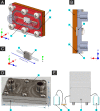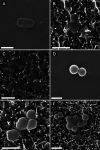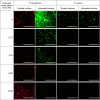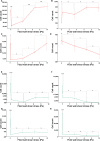Bactericidal Efficacy of Nanostructured Surfaces Increases under Flow Conditions
- PMID: 36406483
- PMCID: PMC9670296
- DOI: 10.1021/acsomega.2c05828
Bactericidal Efficacy of Nanostructured Surfaces Increases under Flow Conditions
Abstract
Bacterial colonization on solid surfaces creates enormous problems across various industries causing billions of dollars' worth of economic damages and costing human lives. Biomimicking nanostructured surfaces have demonstrated a promising future in mitigating bacterial colonization and related issues. The importance of this non-chemical method has been elevated due to bacterial evolvement into antibiotic and antiseptic-resistant strains. However, bacterial attachment and viability on nanostructured surfaces under fluid flow conditions has not been investigated thoroughly. In this study, attachment and viability of Pseudomonas aeruginosa (P. aeruginosa) and Staphylococcus aureus (S. aureus) on a model nanostructured surface were studied under fluid flow conditions. A wide range of flow rates resulting in a broad spectrum of fluid wall shear stress on a nanostructured surface representing various application conditions were experimentally investigated. The bacterial suspension was pumped through a custom-designed microfluidic device (MFD) that contains a sterile Ti-6Al-4V substrate. The surface of the titanium substrate was modified using a hydrothermal synthesis process to fabricate the nanowire structure on the surface. The results of the current study show that the fluid flow significantly reduces bacterial adhesion onto nanostructured surfaces and significantly reduces the viability of adherent cells. Interestingly, the bactericidal efficacy of the nanostructured surface was increased under the flow by ∼1.5-fold against P. aeruginosa and ∼3-fold against S. aureus under static conditions. The bactericidal efficacy had no dependency on the fluid wall shear stress level. However, trends in the dead-cell count with the fluid wall shear were slightly different between the two species. These findings will be highly useful in developing and optimizing nanostructures in the laboratory as well as translating them into successful industrial applications. These findings may be used to develop antibacterial surfaces on biomedical equipment such as catheters and vascular stents or industrial applications such as ship hulls and pipelines where bacterial colonization is a great challenge.
© 2022 The Authors. Published by American Chemical Society.
Conflict of interest statement
The authors declare no competing financial interest.
Figures







Similar articles
-
The effect of the dual scale surface topography of a surface-modified titanium alloy on its bactericidal activity against Pseudomonas aeruginosa.RSC Adv. 2025 Mar 6;15(9):7209-7223. doi: 10.1039/d4ra07843h. eCollection 2025 Feb 26. RSC Adv. 2025. PMID: 40052105 Free PMC article.
-
Preferential adhesion of bacterial cells onto top- and bottom-mounted nanostructured surfaces under flow conditions.Nanoscale Adv. 2023 Oct 12;5(23):6458-6472. doi: 10.1039/d3na00581j. eCollection 2023 Nov 21. Nanoscale Adv. 2023. PMID: 38024307 Free PMC article.
-
Fluid Flow Induces Differential Detachment of Live and Dead Bacterial Cells from Nanostructured Surfaces.ACS Omega. 2022 Jun 28;7(27):23201-23212. doi: 10.1021/acsomega.2c01208. eCollection 2022 Jul 12. ACS Omega. 2022. PMID: 35847259 Free PMC article.
-
Bactericidal efficiency of micro- and nanostructured surfaces: a critical perspective.RSC Adv. 2021 Jan 13;11(3):1883-1900. doi: 10.1039/d0ra08878a. eCollection 2021 Jan 4. RSC Adv. 2021. PMID: 35424086 Free PMC article. Review.
-
Interplay between Immune and Bacterial Cells on a Biomimetic Nanostructured Surface: A "Race for the Surface" Study.ACS Appl Bio Mater. 2023 Sep 18;6(9):3472-3483. doi: 10.1021/acsabm.3c00351. Epub 2023 Jun 29. ACS Appl Bio Mater. 2023. PMID: 37384836 Review.
Cited by
-
The effect of the dual scale surface topography of a surface-modified titanium alloy on its bactericidal activity against Pseudomonas aeruginosa.RSC Adv. 2025 Mar 6;15(9):7209-7223. doi: 10.1039/d4ra07843h. eCollection 2025 Feb 26. RSC Adv. 2025. PMID: 40052105 Free PMC article.
-
Preferential adhesion of bacterial cells onto top- and bottom-mounted nanostructured surfaces under flow conditions.Nanoscale Adv. 2023 Oct 12;5(23):6458-6472. doi: 10.1039/d3na00581j. eCollection 2023 Nov 21. Nanoscale Adv. 2023. PMID: 38024307 Free PMC article.
References
-
- Brown L. M.; McComb J. P.; Vangsness M. D.; Bowen L. L.; Mueller S. S.; Balster L. M.; Bleckmann C. A. Community Dynamics and Phylogenetics of Bacteria Fouling Jet A and JP-8 Aviation Fuel. Int. Biodeterior. Biodegrad. 2010, 64, 253–261. 10.1016/j.ibiod.2010.01.008. - DOI
LinkOut - more resources
Full Text Sources

